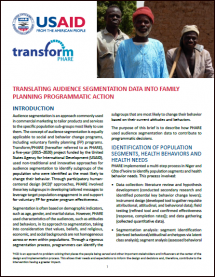Innovation Brief: Translating Audience Segmentation Data into Family Planning Programmatic Action
Audience segmentation is an approach commonly used in commercial marketing to tailor products and services to the specific population sub-groups most likely to use them.
The concept of audience segmentation is equally applicable to social and behavior change programs, including voluntary family planning (FP) programs. Through a rigorous segmentation process, programmers can identify the subgroups that are most likely to change their behavior based on their current attitudes and behaviors.
The purpose of this brief is to describe how PHARE used audience segmentation data to contribute to programmatic decisions.
Last modified: March 1, 2021

